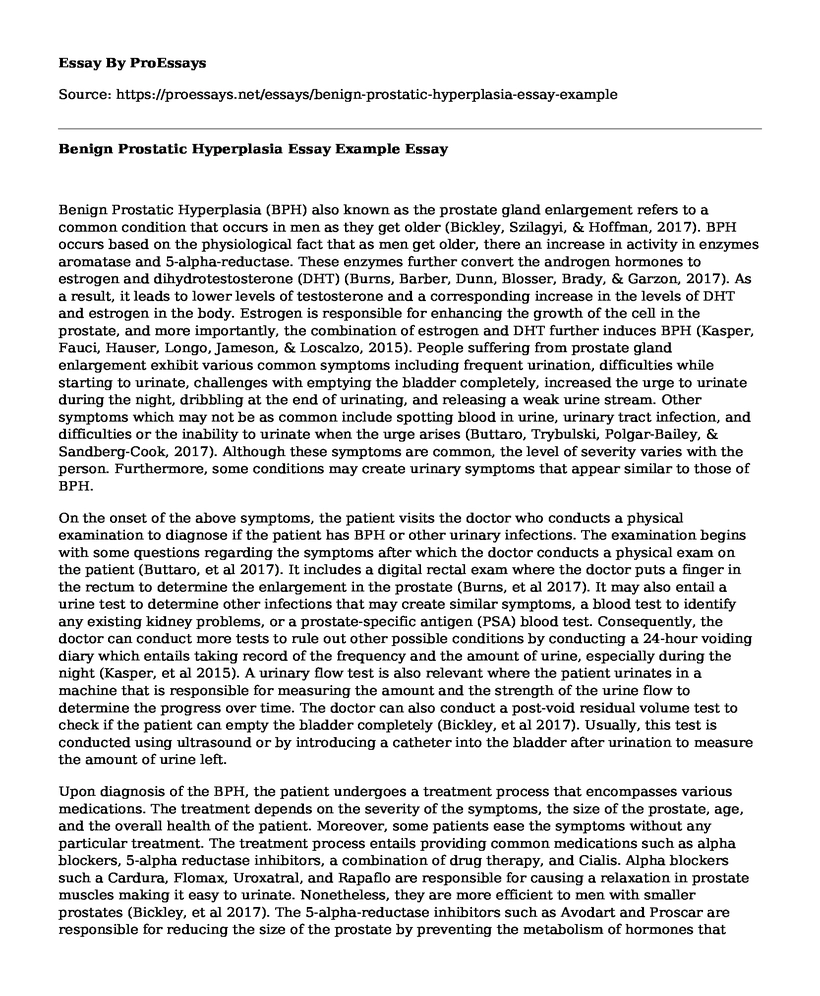Benign Prostatic Hyperplasia (BPH) also known as the prostate gland enlargement refers to a common condition that occurs in men as they get older (Bickley, Szilagyi, & Hoffman, 2017). BPH occurs based on the physiological fact that as men get older, there an increase in activity in enzymes aromatase and 5-alpha-reductase. These enzymes further convert the androgen hormones to estrogen and dihydrotestosterone (DHT) (Burns, Barber, Dunn, Blosser, Brady, & Garzon, 2017). As a result, it leads to lower levels of testosterone and a corresponding increase in the levels of DHT and estrogen in the body. Estrogen is responsible for enhancing the growth of the cell in the prostate, and more importantly, the combination of estrogen and DHT further induces BPH (Kasper, Fauci, Hauser, Longo, Jameson, & Loscalzo, 2015). People suffering from prostate gland enlargement exhibit various common symptoms including frequent urination, difficulties while starting to urinate, challenges with emptying the bladder completely, increased the urge to urinate during the night, dribbling at the end of urinating, and releasing a weak urine stream. Other symptoms which may not be as common include spotting blood in urine, urinary tract infection, and difficulties or the inability to urinate when the urge arises (Buttaro, Trybulski, Polgar-Bailey, & Sandberg-Cook, 2017). Although these symptoms are common, the level of severity varies with the person. Furthermore, some conditions may create urinary symptoms that appear similar to those of BPH.
On the onset of the above symptoms, the patient visits the doctor who conducts a physical examination to diagnose if the patient has BPH or other urinary infections. The examination begins with some questions regarding the symptoms after which the doctor conducts a physical exam on the patient (Buttaro, et al 2017). It includes a digital rectal exam where the doctor puts a finger in the rectum to determine the enlargement in the prostate (Burns, et al 2017). It may also entail a urine test to determine other infections that may create similar symptoms, a blood test to identify any existing kidney problems, or a prostate-specific antigen (PSA) blood test. Consequently, the doctor can conduct more tests to rule out other possible conditions by conducting a 24-hour voiding diary which entails taking record of the frequency and the amount of urine, especially during the night (Kasper, et al 2015). A urinary flow test is also relevant where the patient urinates in a machine that is responsible for measuring the amount and the strength of the urine flow to determine the progress over time. The doctor can also conduct a post-void residual volume test to check if the patient can empty the bladder completely (Bickley, et al 2017). Usually, this test is conducted using ultrasound or by introducing a catheter into the bladder after urination to measure the amount of urine left.
Upon diagnosis of the BPH, the patient undergoes a treatment process that encompasses various medications. The treatment depends on the severity of the symptoms, the size of the prostate, age, and the overall health of the patient. Moreover, some patients ease the symptoms without any particular treatment. The treatment process entails providing common medications such as alpha blockers, 5-alpha reductase inhibitors, a combination of drug therapy, and Cialis. Alpha blockers such a Cardura, Flomax, Uroxatral, and Rapaflo are responsible for causing a relaxation in prostate muscles making it easy to urinate. Nonetheless, they are more efficient to men with smaller prostates (Bickley, et al 2017). The 5-alpha-reductase inhibitors such as Avodart and Proscar are responsible for reducing the size of the prostate by preventing the metabolism of hormones that induce prostate growth. In combining the drug therapy, a doctor can recommend a patient to take both the alpha-blocker and the 5-alpha-reductase inhibitor on a case where a single medication is not effective. Lastly, Cialis is a medication responsible for treating erectile dysfunction which can also treat BPH as well (Kasper, et al 2015).
References
Bickley, L. S., Szilagyi, P. G., & Hoffman, R. M. (2017). Bates' guide to physical examination and history taking. 12th Edition, Philadelphia : Wolters Kluwer
Burns, C. E., Barber, S. N., Dunn, A. M. N., Blosser, C. G., Brady, M. A., & Garzon, D. L. (2017). 6th Edition, Pediatric primary care. St. Louis, Missouri : Elsevier
Buttaro, T. M., Trybulski, J. A., Polgar-Bailey, P., & Sandberg-Cook, J. (2017). Primary care: A collaborative practice. 5th Edition., St. Louis, Missouri : Elsevier.
Kasper, D. L., Fauci, A. S., Hauser, S. L., Longo, D. L., Jameson, J. L., & Loscalzo, J. (2015). Harrison's principles of internal medicine. 19th Edition, New York : McGraw Hill Education.
Cite this page
Benign Prostatic Hyperplasia Essay Example. (2022, Jul 18). Retrieved from https://proessays.net/essays/benign-prostatic-hyperplasia-essay-example
If you are the original author of this essay and no longer wish to have it published on the ProEssays website, please click below to request its removal:
- Vestibular Rehabilitation Essay
- Critical Infrastructure and Key Resources (Cikr) Essay
- Legalized Medical Use of Marijuana to Treat Cancer or MS Essay Example
- Essay on 125,000+ Infected, 4,600+ Dead: Preparing for the Global COVID-19 Crisis
- Nursing Communication: Active Listening and Trust - Essay Sample
- Essay Sample on Mental Health Crisis: 40M Adults in US Suffer, Yet Few Receive Treatment
- Electronic Cigarette - Essay Example







